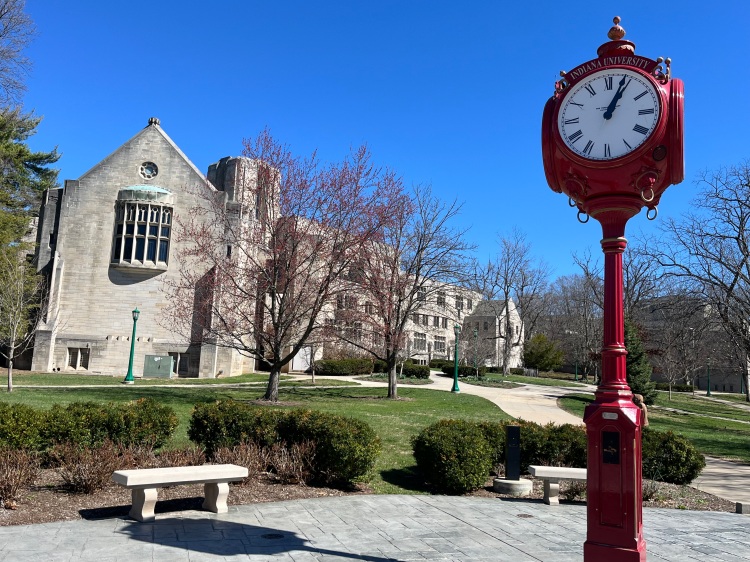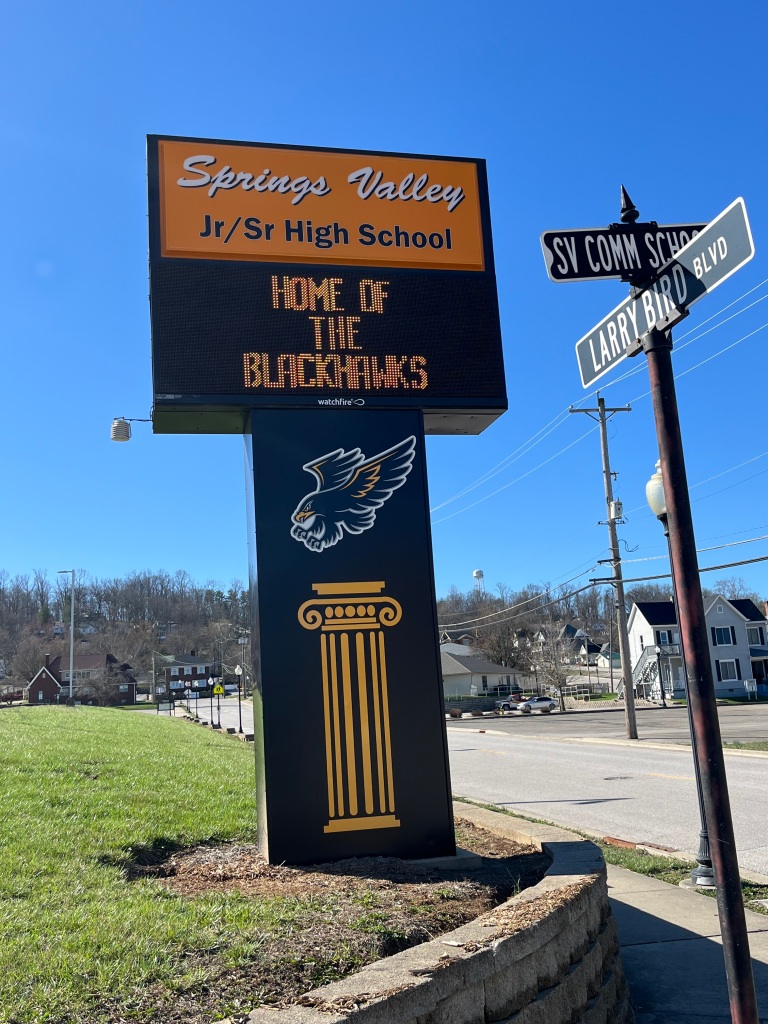
Never daunted, we cannot falter
In the battle, we’re tried and true
Indiana, our Indiana
Indiana we’re all for you! I-U!
BLOOMINGTON, Indiana – Most of the 16,000-plus fans were clearly all for Indiana on a crisp, sunny Sunday afternoon here in the heart of the Hoosier State.
That would include myself, admittedly a college sports nut, and wife Vicki, who has become a fan of college athletics largely through osmosis , i.e. married to me for nearly 47 years. I’ve had a long fascination with college football stadiums and college basketball arenas. Iconic Assembly Hall, if not the Holy Grail, was as least toward the top of my bucket list.
I had seen countless televised games from venerable Assembly Hall. To finally step inside the 53-year-old arena was a thrill (I know, I’m easily entertained). My eyes immediately went to the familiar outline of the state of Indiana at half court, and the iconic steep wall behind one basket. The majority of the 17,222 seats are along the sideline. Only a limited number of seats are behind the two baskets. Assembly Hall is known for its unique design of steep sides, which combined with capacity crowds, makes it one of the loudest venues in college basketball. A 2012 poll of four ESPN pundits ranked it third in terms of best home-court advantage in the country.
It’s more than steep sides and big crowds, however, that has made this place a living hell for opponents. More often, it’s been the home team wearing crimson and cream. Assembly Hall has been the home to three national championships, 32 straight winning teams, 14 conference champions and home winning streaks of 50 and 35 games.
Before the game, Vicki and I toured the massive lobby leading to the arena, which proudly displays the school’s championship banners, trophies and sculptures of Indiana greats. We had our picture taken in front of the sculptures of Indiana’s unbeaten, national championship team from the 1975-76 season.

The Hoosier team we saw play Michigan State isn’t one of those great teams. These days, Indiana is middle-of-the-pack in the Big Ten, a far cry from the perennial national championship contenders under legendary Coach Bob Knight, whose 29-year reign abruptly ended with his controversial firing in 2000.
Twenty-four years later, however, the coach they called “The General” still casts a long shadow. Alhough you won’t find a statue of Knight in or outside the building (Knight’s choice), his image popped up frequently on the video screen overhead the court. Perched in our balcony seats high above the Indiana bench, I could only imagine what it was like that day in 1985 when Knight, in a fit of rage, famously threw a chair across the court after being assessed a technical. You can watch it here:
https://www.youtube.com/watch?v=ukpekodCQ-U
The Knight-Indiana divorce was messy. The bitter coach for many years refused to show his face at Assembly Hall, even though he had moved back to Bloomington after retiring from coaching at Texas Tech in 2008. He finally relented in 2020 to attend a game along with many of his former players, about 20 years after his ouster. The Hoosier crowd roared. Less than three years later, he passed away at the age of 83.
Despite the program’s downturn after the Knight era, you’d think this last game of the regular season had conference title implications. The near-capacity, Hoosier faithful were on their feet for much of the game, clapping in unison whenever the pep band played the school’s fight song “Indiana, Our Indiana,” during timeouts, and roaring with approval when the home team went on a scoring run.
The University of Washington needs to work on its game-day experience once it enters the Big Ten next fall. Basketball is more than just a game here in the Heartland. In Indiana, it’s a way of life. The Huskies will not only face good basketball teams in their new conference, but big-time venues fueled by large, passionate crowds.
On this second Sunday in March, the hot-shooting Hoosiers jumped out to a 20-5 lead, only to fall behind in the second half before rallying at the end for a nail-biting, 65-64 victory.
Before the game, we took a walk through the old part of IU’s beautiful campus. Most or all of the buildings are built from Indiana limestone mined from the famous quarries south of Bloomington, also known as “B-Town.” We also stopped in at the Student Union Building, which houses the bookstore and a massive selection of IU shirts, hats and other gear. The Journalism School is next door, named after its most famous alum, Pulitzer Prize-winning journalist and World War II correspondent Ernie Pyle.
All of these tour tips came from my former boss, Bob Silver, who served as sports editor at The Seattle Times early in my tenure there. Bob is an IU alum, and was a member of the school’s swim team. Bob now lives in Walla Walla, Washington, and is retired, but says he if were to ever live in the Midwest again, he’d choose Bloomington.

French Lick? Hick, yes!
We flew to Indiana to visit our daughter, Greta, and family, who live in Valparaiso. In previous visits we had never ventured south of Indianapolis. But this time, after three days in Louisville, Kentucky, we took some back roads to French Lick, the home of Boston Celtic legend Larry Bird, on our way to Bloomington.
I will have to say this stop off the beaten path took some convincing. Vicki was not a fan of the extra 45 minutes it would add to the drive to B-Town and the Indiana-Michigan State basketball game later that afternoon. But this wide spot in the road in southwest Indiana was also on my bucket list.

We drove down Larry Bird Boulevard to his old stomping grounds, Springs Valley High School and the teen center and outdoor court where he used to play. A bust of Larry Bird resides outside the teen center.

Larry Bird, if you haven’t heard of him, is widely regarded as one of the greatest basketball players of all time. That he played ball at tiny Springs Valley High School in one of the poorest regions of the state is even more remarkable.
Larry’s father, Joe Bird, struggled to hold a job. A veteran of the Korean War, he suffered from what we know now as post traumatic stress disorder. He was a heavy drinker. He often threatened to kill himself. Finally, he delivered on that promise, taking his life at age 48. The financial burden in the family fell to Bird’s mother, Georgia. As a waitress at a restaurant, she barely made enough to put food on the table.
Years later, Bird would say, “growing up we didn’t have much. I just spent all my time playing basketball.”
Even so, Bird was not an instant sensation. He barely made the varsity team as a 6-foot-1 sophomore. As a junior he had grown two more inches, but was known more as a defensive specialist. But by his senior year, he put it all together. He had grown to six-foot-seven-inches. As he perfected his offensive game, he began to dominate high-school competition.

Playing in front of a a packed house in his home gym for every game, Bird averaged 30.6 points and 20.5 rebounds his senior season, making the all-state team. He was offered scholarships to Kentucky and Indiana, among others, choosing to sign with Bob Knight’s Hoosiers. But whether it was living in the bigger city of Bloomington, or he got cold feet at the prospect of playing for the demanding and volatile Knight, one month into his freshman year Bird walked away. He returned to French Lick, enrolled in a local school, Northwood Institute, and went to work as a garbage man to help pay for tuition. He would eventually leave that school as well. Indiana State Coach Bill Hodges, however, didn’t give up on Bird and convinced him to join the Sycamores in Terre Haute the following season.
Bird would soon become among the leading scorers in the nation. After being drafted by the Boston Celtics after his junior season, Bird elected to return to college for the 1978-79 season. He would lead Indiana State to an undefeated regular season, and finished the season with a national championship game matchup with future NBA great Magic Johnson and Michigan State. The Spartans won in one of the most-watched title games in history, a game which elevated college basketball to another level.
Eventually, the “Hick from French Lick” would be known around the world as “Larry Legend.” Bird would play all 13 of his NBA seasons with Boston, leading them to three NBA championships. He was a 12-time NBA All-Star, won two NBA Finals MVP awards and received the NBA Most Valuable Player award three consecutive times (1984-86).
Not bad for a Hick from French Lick.
Bucket list checked.